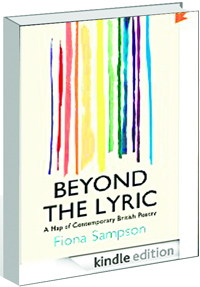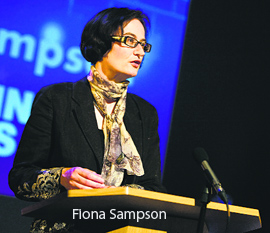|
…And then a poem is born
Reviewed by B. L. Chakoo
Beyond The Lyric: A Map of Contemporary British Poetry
by Fiona Sampson.
London: Chatto & Windus. Pages 309. £16.99.
 Given
that poetry has been written in every culture and era, and therefore
in many widely differentiated ways, not to mention languages, this
kind of belief that there’s only one way of writing is clear folly.
However, it is folly encouraged by the fantasy that poetry always
proceeds by movements. This old-fashioned concept is a legacy of
modernism. Wedded to the early twentieth-century idea of an avant
garde, it suggests that we can only read literary practice as a
chronological series of unified movements, each occupying the entire
poetic foreground and sweeping away whatever came before. True enough,
poetry is written in its own contemporary context. "But that
context is more nuanced, even fragmented, than this fantasy
suggests." Given
that poetry has been written in every culture and era, and therefore
in many widely differentiated ways, not to mention languages, this
kind of belief that there’s only one way of writing is clear folly.
However, it is folly encouraged by the fantasy that poetry always
proceeds by movements. This old-fashioned concept is a legacy of
modernism. Wedded to the early twentieth-century idea of an avant
garde, it suggests that we can only read literary practice as a
chronological series of unified movements, each occupying the entire
poetic foreground and sweeping away whatever came before. True enough,
poetry is written in its own contemporary context. "But that
context is more nuanced, even fragmented, than this fantasy
suggests."
This is what Sampson
very correctly writes in her exciting but also terser introduction to Beyond
the Lyric: A Map of Contemporary British Poetry, which—besides
being an interesting book of enthusiasms, a sagacious and witty map of
contemporary British poetry, and a new, accessible guide to living
British poets assembled for the first time according to the "kind
of poetry" they write—revolves around this argument. In fact,
poetry in Britain today is no longer the dialect of a relatively
small, "white male middle-class, tribe, nor the product of
homogenous education system, culture and society." It is mostly
porous, susceptible to many influences, from "junk TV to
international travel." Thus by grouping living British poets
according to the "varieties" of poetry they write, rather
than by their thematic concerns, Sampson, who herself is a remarkably
many-layered poet, identifies in this book 13 tendencies or species in
contemporary British poetry, and presents her view of lyric as an
intense, imaginative form of self-expression or self-consciousness.
Like Alastair Fowler, she believes that in contemporary British poetry
the collapse of many kinds into lyric has given "subgenre an
enlarged function." However, she does not value poems for the
issues they raise or read them for their "geographical or social
contexts." Throughout this authoritative book, her notion of
lyric as essentially the personal utterance of a poet’s feelings
takes its root in the early nineteenth century—that is when the
readers derived their assumption about poetry in general, and lyric in
particular, from Wordsworth’s famous idea of poetry as
"spontaneous overflow of powerful feeling."
 As
we proceed, Beyond The Lyric seems to grow more and more
interesting, not only because of additional information about the
poets who have written on sex, love, death and loss in "every
culture since the time of Sappho," but because a certain
conformity to deep and interesting patterns in contemporary British
verse—which has been for a very long time, "cantankerous,
quarrelsome, fascinating and extraordinary" – is being made
more obvious. Thus the book opens with the "Plain Dealers"
of British poetry, who all claim that their straightforward,
"bread and butter diction" and emotional intelligence is not
so much "a conscious strategy as an absence of affectation, and
ends on the capacious generosity of the "Expanded Lyric",
which cleverly maintains that bold and even radical lyric expansion
has become "a flamboyant presence" in the centre ground of
contemporary British poetry. The essays in between are vibrant with
critical responsibility. They insightfully examine the contemporary
propensities from the poetic swagger of the Dandies to a network of
friendship, collegiality and mutual influence of the Oxford Elegists;
from the layered and fascinating verse of Mythopoesis to the hasty
explorations of the New Formalists. Each essay’s subject is
important and its research has evidently been diligent. We get to know
a lot more about lyric poetry than we did, and the increment of
knowledge is not always trivial. As
we proceed, Beyond The Lyric seems to grow more and more
interesting, not only because of additional information about the
poets who have written on sex, love, death and loss in "every
culture since the time of Sappho," but because a certain
conformity to deep and interesting patterns in contemporary British
verse—which has been for a very long time, "cantankerous,
quarrelsome, fascinating and extraordinary" – is being made
more obvious. Thus the book opens with the "Plain Dealers"
of British poetry, who all claim that their straightforward,
"bread and butter diction" and emotional intelligence is not
so much "a conscious strategy as an absence of affectation, and
ends on the capacious generosity of the "Expanded Lyric",
which cleverly maintains that bold and even radical lyric expansion
has become "a flamboyant presence" in the centre ground of
contemporary British poetry. The essays in between are vibrant with
critical responsibility. They insightfully examine the contemporary
propensities from the poetic swagger of the Dandies to a network of
friendship, collegiality and mutual influence of the Oxford Elegists;
from the layered and fascinating verse of Mythopoesis to the hasty
explorations of the New Formalists. Each essay’s subject is
important and its research has evidently been diligent. We get to know
a lot more about lyric poetry than we did, and the increment of
knowledge is not always trivial.
In brief, Beyond The
Lyric is more sober, but may prove standard for the present
generation interested in "dipping a toe" into contemporary
British verse. The impression left is that Fiona Sampson is excellent
critical company and that here is book which is designed to do the
opposite, "unpacking possibilities and opening up growing room
for new poets."
|